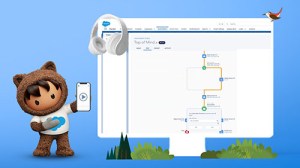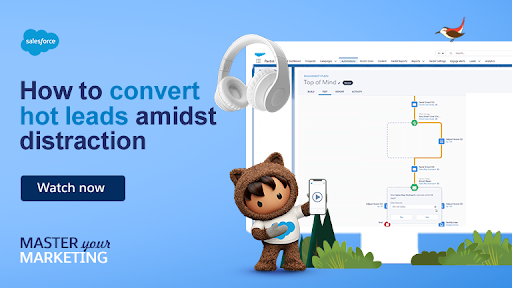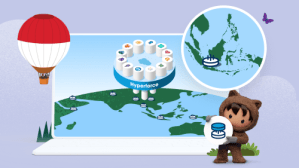Master Your Marketing: How To Convert More Leads With Pardot



Read about six of the ways Pardot helps small businesses automate their marketing, engage with customers, and convert more leads.

Dan Scodellaro
One of the primary goals for any small business leader, or marketer, is to generate new leads and grow their business. With so much communication going on in the digital space, how do you identify the marketing tactics that generate real returns?
The answer is automation. By employing marketing automation like Pardot, you can expect to grow your business by up to 30%.
Since the beginning of the pandemic, businesses all across the ASEAN region have been adapting quickly to the digital revolution. But to succeed in a competitive market, you have to excel. According to research conducted by Salesforce, 80% of customers value brand experience as much as products. Small and growing businesses will need to deliver personalised messaging across channels to stay competitive.
One of the major stumbling blocks many small businesses face is their systems make it difficult for sales and marketing teams to work together. Often, activities end up being duplicated. This can lead to confusion for the customer, especially if they receive inconsistent messaging from the same company. With Pardot, sales and marketing teams can sync their activities, reduce duplication, and speed up the sales process.
With that in mind, here are six ways that Pardot can help you convert more leads:
1. Take advantage of real-time data
It’s long been accepted in the sales community that ‘speed to lead’ is vitally important. Our own research tells us that 83% of customers expect to engage with someone immediately when contacting a company. Not all systems allow this kind of speed.
Marketing leads gathered by Pardot can be worked on straight away, giving your sales team the advantage. Submissions made via online forms are added in real time to your CRM, allowing sales teams to get a headstart on qualifying and converting leads. Imagine how many more leads you could convert if you contacted leads within a few hours, or even minutes, rather than the next day.
2. Prioritise with automatic lead scoring
Leads gathered by a simple email system are often dealt with in the order that they arrive in the salesperson’s inbox.
Pardot, however, can automatically score and prioritise leads based on their activities prior to submitting a form. Prospects can be ranked based on a whole range of metrics. For example, which ad they clicked on, which pages on your website they looked at, and their engagement with any email communication they may have received. This means that your sales teams can contact the top ranked, most engaged leads first, before your competitors.
3. Nurture leads for the future
Not all customers who fill in a web form are ready to buy. If a member of your sales team calls a lead who isn’t in a position to make a purchase, they might get pushed to the bottom of the list.
What if all that prospect needed was a little more information, and a little more warming up? Without integration between sales and marketing, leads who don’t immediately buy might never see any marketing messages. Pardot allows sales teams to pass unresponsive leads back to marketing for nurturing. It also allows salespeople to send marketing-approved email campaigns.
4. Personalise your messages with dynamic engagement builder
Without a dynamic system like Pardot, creating personalised marketing messages for each contact can be difficult. Fifty-two percent of customers expect offers to always be personalised, and this number is rising.
Pardot makes personalised, always-on marketing possible. Sales teams can effortlessly build tailored campaigns with marketing-curated content, meaning deals can be closed faster. Marketing teams can send bespoke communications to leads based on their profile, their position in the marketing funnel, and their engagement with the business so far. By offering powerful segmentation tools, linked to your CRM data, Pardot allows both sales and marketing teams to target exactly the right customers at exactly the right time.
Bangkok-based abrasives company SmartCost used Pardot to drive a 40% increase in conversions. Pardot is integrated with Sales Cloud and Service Cloud to track all emails sent to customers. “Pardot helps us design content that relates to customers’ interests,” says Krittakorn Wongsuttipakorn, Founder and CEO. “Our sales team can analyse data collected in Salesforce and prepare information based on the customer’s interest before calling or visiting the customer.”
5. Optimise campaigns with marketing analytics
To understand whether your efforts are working, you need to measure the performance of your campaigns. Pardot’s out-of-the-box analytics tools give you all the information you need to understand your returns on investment. This information can be fed back into campaigns, driving higher and faster conversions.
IT solutions company Riverplus has seen a 30% increase in lead conversion since using Pardot. It has also seen a 300% increase in revenue since adopting Salesforce. As Choonrakai Singprasert, Owner and Managing Director, says, “Selling is science. You can’t rely on what you think; you need detailed information to forecast and make sales. Salesforce gives us that information and helps us grow.”
6. Give sales teams a live engagement history
For sales teams to get the best out of each interaction with their leads, they have to have all the information they need at their fingertips.
Pardot saves the entire customer engagement history, and makes it available to the salesperson wherever they need it – in the office, or out on the road. Before a call, or a meeting, the salesperson can review the customer’s history, and use that information to make their interactions more personalised and relevant. This history is updated in real time. It is also integrated with your CRM to ensure that every team has the information they need.
Achieve rapid return on investment
Pardot integrates with all of Salesforce’s advanced solutions. Therefore, as your business grows, your processes can grow with you. Of course, you need to know that your investment is going to provide you with the returns to make it worthwhile. The Pardot team have you covered: take a look at our Time-to-Value Guide for Small and Medium Businesses.
For more insights, watch our webinar ‘Master your Marketing: How to convert hot leads amidst distraction’. We discuss all the benefits of marketing automation to help your small business grow at record speeds.





















